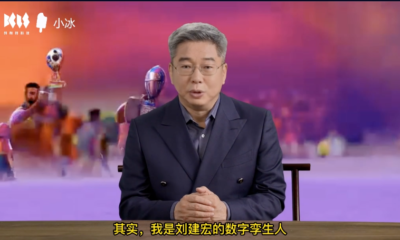Politics
Could ChatGPT Pose a Threat to Google’s Dominance in Search?
Published
1 year agoon
By
Drew Simpson
Over the decades, Google has made a space in billions of people’s lives worldwide as the go-to search engine to answer their queries. From using it to learn “how to make a pecan pie” to diagnosing illnesses by inputting symptoms, Google, with its infamous and complicated ranking algorithm, is all-knowing.
But with innovation in artificial intelligence (AI) and the launch of OpenAI’s language generation model ChatGPT, things have changed. The world has been thrown into chaos, and Google’s monopoly among search engines may finally be wavering.
Introduction to ChatGPT and Google’s search engine
The Google Search Engine is now three decades old. The speed, simplicity, and quality of results make Google the most-used search engine on the internet. It uses a search algorithm known as PageRank, which combines technical factors, such as the relevance and popularity of web pages, to rank the results returned for a given query.
The search algorithm takes many factors into account when determining the relevance of a web page. This includes the text, the links, and the relevance of the words in the query.
The algorithm’s intent is to help users find the most useful and informative web pages for their queries. The trustworthiness and relevance of these results, however, are questionable.
ChatGPT, on the other hand, is a natural language generation model by OpenAI. It can be used for various natural language processing tasks. From generating text, answering questions, generating responses to prompts, language translation, and even text summarization, ChatGPT is multifaceted.
A comparison of ChatGPT and Google’s search engine capabilities
Search is a complex task. Google search involves not just understanding natural language queries — but also ranking and organizing the billions of web pages and documents that are indexed on Google. This requires sophisticated algorithms and a deep understanding of the structure of the web, which Google has done through years of research and development.
Let’s go over some of the wide range of tasks that the Google search engine is capable of:
- Web Search: The primary function of Google Search is to help users find information on the web. Users can type in keywords or phrases, and the search engine will return a list of relevant web pages and documents.
- Image Search: This feature allows users to search for images on the internet by keywords.
- News Search: Google Search includes a feature that allows users to find news articles about a specific topic.
- Video Search: It also allows users to search for videos on the internet by keywords.
- Maps and Local Search: This feature enables users to search for businesses, places, and other points of interest and view them on a map.
- Advanced Search: Google Search includes advanced search operators such as ‘site:,’ ‘filetype:,’ ‘intext:’ and many more to help users refine their search results and find the information they need.
ChatGPT, on the other hand, is not explicitly designed for use in search. But even in its primary stage, it has shown tremendous potential in assisting with search. While it can generate text similar to human writing, it is not currently as sophisticated as Google’s search algorithm, which has been developed and refined over many years.
How ChatGPT can improve the Search Experience
It’s currently missing many of the components that make Google’s search so powerful, such as a vast array of data, years of research and development, and a wide range of integrated products and services.
It is worth mentioning that ChatGPT, when used in conjunction with a search engine like Google, can assist in providing more sophisticated results as well as a more interpretable understanding of queried information.
Let’s look at some ways ChatGPT can be of aid when it comes to search.
- Query Understanding: ChatGPT can understand the intent of a user’s query by analyzing the query and generating a summary of what the user is looking for.
- Query Expansion: It can also expand a user’s query by generating similar or related queries.
- Language Translation: Can be fine-tune on a specific language task, allowing it to generate text in a different language than the one it was trained on, providing a more accurate and human-like translation.
- Answer Generation: It can generate answers to natural language questions.
- Text Summarization: ChatGPT can generate summaries of lengthy articles or documents, making it easier for users to find the information they are looking for.
- Text Completion: It can also complete a text based on a given prompt or context.
- Rich Snippet: ChatGPT can generate rich snippets, giving a better visual representation of the result.
- Responding to Voice Queries: ChatGPT can be integrated with voice-enabled devices, allowing it to respond to natural language voice queries and generate spoken responses.
These are just a few examples of how ChatGPT can enhance search. The model can be fine-tune for specific use cases, and its capabilities can extend through integration with other technologies.
Potential uses of ChatGPT in various industries and sectors
ChatGPT and other language models have great potential in many other fields, such as customer support, content creation, summarization, and search. Because of its efficiency, scalability, cost-effectiveness, coherence, and fluency, ChatGPT use cases expand to every major industry.
- Education: ChatGPT can be fine-tune on educational data and knowledge to generate text for exam questions, summaries, and explanations.
- Healthcare: ChatGPT has the ability to use medical data and knowledge to develop medical reports and summaries or answer patients’ questions.
- Legal: Inputting legal data and knowledge in ChatGPT allows it to assist with legal documents, summaries, and contract reviews.
- E-commerce: Can effectively generate product descriptions and customer reviews. It can also power chatbots to help customers find the products they are looking for and make purchase decisions.
- Customer Service: ChatGPT can facilitate chatbot or virtual assistants that can answer customer questions, providing quick and accurate responses 24/7.
Potential threats Google may face with the development of AI Models
Language generation is a rapidly evolving field, and ChatGPT comes with certain unique abilities. These may cause problems for Google. Let’s find out how this works.
- Automation of content creation: One of the key benefits of ChatGPT is its ability to generate human-like text. This could lead to the automation of certain content creation tasks. News articles, product descriptions, and customer reviews — can all be AI-generated, making it difficult for Google to discern between them. The lack of being able to actually tell the difference between real and AI throws the Google ranking algorithm into chaos.
- Personalization: ChatGPT can be fine-tuned on specific tasks and can generate customizable text for a particular context. While Google search is more general and not tailored to specific use cases.
- Competition in the advertising industry: Google generates a significant portion of its revenue through advertising. ChatGPT, however, can generate ad copy, potentially leading to increased competition in the advertising industry.
- Quality of results: Google’s search results rank by relevance. However, ChatGPT can provide results that humans prefer as they are in a conversational tone. This makes ChatGPT more efficient for Google’s search results.
- Reducing the need for Google search: ChatGPT can be fine-tuned on specific tasks and generate human-like text. This reduces the need for users to rely on Google Search for certain types of information.
The current state and future potential of ChatGPT and Google’s search engine
Google has created its own transformation-based language model, LaMDA. However, Google has been very cautious about making it available to the masses. OpenAI, on the other hand, has readily made ChatGPT available as a research preview, with the program gaining 1 million users in just five days.
ChatGPT has done a brilliant job of highlighting the capabilities of current AI. Head of Google’s AI, Jeff Dean, said the company has much more “reputational risk” in providing wrong information and thus is moving “more conservatively than a small startup.”
They went on to say that they had similar capabilities but much more to lose because people have to trust the answers they get from Google, which is not always the case with ChatGPT, as OpenAI has explicitly stated that ChatGPT “sometimes writes plausible-sounding but incorrect or nonsensical answers.”
It is also important to note that ChatGPT, like any other machine learning model, is not a silver bullet. This means that its performance depends on the data it’s trained on and the specific task it’s used for.
A search engine like Google needs to understand the intent of a user’s query and then provide relevant results. However, ChatGPT can generate text similar to human writing but is not fully able to carry out the former.
Additionally, GPT-3 and its variants are only open for some to use, as it requires API access which is not available for free. Thus there are limitations to its ability. Only large enterprises can afford it right now. Which also limits its potential to pose a real threat to Google in search.
Conclusion: Is ChatGPT a viable threat to Google’s dominance in search?
Google is now live for more than 30 years, which has advanced its algorithms and capabilities. Additionally, Google has a vast array of data at its disposal. This allows it to continuously improve its search algorithms and provide more accurate and relevant results.
Google also has a wide range of other products and services. Google Maps, Images, and YouTube play a vital role in the search experience. This integration of Google products provides a comprehensive search experience to its users.
ChatGPT is not currently a direct threat to Google’s dominance, but it can be a potential tool to assist the future search experience. Research is done in this area, but there is much more to search for. It’s not an easy task, but it’s a possible one.
With further innovations, ChatGPT could be major competition to the decades of monopoly Google has been enjoying over search engines. The release and potential success or failure of LaMDA also play a crucial role in determining whether Google will be able to continue asserting this dominance as ChatGPT and other natural-language generation models are wreaking havoc in the digital sphere.
Featured Image Credit: Photo by Oleksandr Pidvalnyi; Pexels; Thank you!
Asim Rais Siddiqui
Asim Rais Siddiqui is a seasoned professional with over 10 years of experience in developing and implementing advanced technology and software solutions. He excels at leveraging his expertise to drive business growth by identifying and capitalizing on new market opportunities and taking calculated risks.
You may like
-


The Download: Google’s Gemini is here, and Sundar Pichai talks AI
-


China has a new plan for judging the safety of generative AI—and it’s packed with details
-


Android 14 debuts: What’s new in Google’s latest mobile OS update?
-


Now you can chat with ChatGPT using your voice
-


The Download: ChatGPT gets even chattier, and recreating space on Earth
-


Deepfakes of Chinese influencers are livestreaming 24/7
Politics
Fintech Kennek raises $12.5M seed round to digitize lending
Published
6 months agoon
10/11/2023By
Drew Simpson
London-based fintech startup Kennek has raised $12.5 million in seed funding to expand its lending operating system.
According to an Oct. 10 tech.eu report, the round was led by HV Capital and included participation from Dutch Founders Fund, AlbionVC, FFVC, Plug & Play Ventures, and Syndicate One. Kennek offers software-as-a-service tools to help non-bank lenders streamline their operations using open banking, open finance, and payments.
The platform aims to automate time-consuming manual tasks and consolidate fragmented data to simplify lending. Xavier De Pauw, founder of Kennek said:
“Until kennek, lenders had to devote countless hours to menial operational tasks and deal with jumbled and hard-coded data – which makes every other part of lending a headache. As former lenders ourselves, we lived and breathed these frustrations, and built kennek to make them a thing of the past.”
The company said the latest funding round was oversubscribed and closed quickly despite the challenging fundraising environment. The new capital will be used to expand Kennek’s engineering team and strengthen its market position in the UK while exploring expansion into other European markets. Barbod Namini, Partner at lead investor HV Capital, commented on the investment:
“Kennek has developed an ambitious and genuinely unique proposition which we think can be the foundation of the entire alternative lending space. […] It is a complicated market and a solution that brings together all information and stakeholders onto a single platform is highly compelling for both lenders & the ecosystem as a whole.”
The fintech lending space has grown rapidly in recent years, but many lenders still rely on legacy systems and manual processes that limit efficiency and scalability. Kennek aims to leverage open banking and data integration to provide lenders with a more streamlined, automated lending experience.
The seed funding will allow the London-based startup to continue developing its platform and expanding its team to meet demand from non-bank lenders looking to digitize operations. Kennek’s focus on the UK and Europe also comes amid rising adoption of open banking and open finance in the regions.
Featured Image Credit: Photo from Kennek.io; Thank you!
Radek Zielinski
Radek Zielinski is an experienced technology and financial journalist with a passion for cybersecurity and futurology.
Politics
Fortune 500’s race for generative AI breakthroughs
Published
6 months agoon
10/11/2023By
Drew Simpson
As excitement around generative AI grows, Fortune 500 companies, including Goldman Sachs, are carefully examining the possible applications of this technology. A recent survey of U.S. executives indicated that 60% believe generative AI will substantially impact their businesses in the long term. However, they anticipate a one to two-year timeframe before implementing their initial solutions. This optimism stems from the potential of generative AI to revolutionize various aspects of businesses, from enhancing customer experiences to optimizing internal processes. In the short term, companies will likely focus on pilot projects and experimentation, gradually integrating generative AI into their operations as they witness its positive influence on efficiency and profitability.
Goldman Sachs’ Cautious Approach to Implementing Generative AI
In a recent interview, Goldman Sachs CIO Marco Argenti revealed that the firm has not yet implemented any generative AI use cases. Instead, the company focuses on experimentation and setting high standards before adopting the technology. Argenti recognized the desire for outcomes in areas like developer and operational efficiency but emphasized ensuring precision before putting experimental AI use cases into production.
According to Argenti, striking the right balance between driving innovation and maintaining accuracy is crucial for successfully integrating generative AI within the firm. Goldman Sachs intends to continue exploring this emerging technology’s potential benefits and applications while diligently assessing risks to ensure it meets the company’s stringent quality standards.
One possible application for Goldman Sachs is in software development, where the company has observed a 20-40% productivity increase during its trials. The goal is for 1,000 developers to utilize generative AI tools by year’s end. However, Argenti emphasized that a well-defined expectation of return on investment is necessary before fully integrating generative AI into production.
To achieve this, the company plans to implement a systematic and strategic approach to adopting generative AI, ensuring that it complements and enhances the skills of its developers. Additionally, Goldman Sachs intends to evaluate the long-term impact of generative AI on their software development processes and the overall quality of the applications being developed.
Goldman Sachs’ approach to AI implementation goes beyond merely executing models. The firm has created a platform encompassing technical, legal, and compliance assessments to filter out improper content and keep track of all interactions. This comprehensive system ensures seamless integration of artificial intelligence in operations while adhering to regulatory standards and maintaining client confidentiality. Moreover, the platform continuously improves and adapts its algorithms, allowing Goldman Sachs to stay at the forefront of technology and offer its clients the most efficient and secure services.
Featured Image Credit: Photo by Google DeepMind; Pexels; Thank you!
Deanna Ritchie
Managing Editor at ReadWrite
Deanna is the Managing Editor at ReadWrite. Previously she worked as the Editor in Chief for Startup Grind and has over 20+ years of experience in content management and content development.
Politics
UK seizes web3 opportunity simplifying crypto regulations
Published
6 months agoon
10/10/2023By
Drew Simpson
As Web3 companies increasingly consider leaving the United States due to regulatory ambiguity, the United Kingdom must simplify its cryptocurrency regulations to attract these businesses. The conservative think tank Policy Exchange recently released a report detailing ten suggestions for improving Web3 regulation in the country. Among the recommendations are reducing liability for token holders in decentralized autonomous organizations (DAOs) and encouraging the Financial Conduct Authority (FCA) to adopt alternative Know Your Customer (KYC) methodologies, such as digital identities and blockchain analytics tools. These suggestions aim to position the UK as a hub for Web3 innovation and attract blockchain-based businesses looking for a more conducive regulatory environment.
Streamlining Cryptocurrency Regulations for Innovation
To make it easier for emerging Web3 companies to navigate existing legal frameworks and contribute to the UK’s digital economy growth, the government must streamline cryptocurrency regulations and adopt forward-looking approaches. By making the regulatory landscape clear and straightforward, the UK can create an environment that fosters innovation, growth, and competitiveness in the global fintech industry.
The Policy Exchange report also recommends not weakening self-hosted wallets or treating proof-of-stake (PoS) services as financial services. This approach aims to protect the fundamental principles of decentralization and user autonomy while strongly emphasizing security and regulatory compliance. By doing so, the UK can nurture an environment that encourages innovation and the continued growth of blockchain technology.
Despite recent strict measures by UK authorities, such as His Majesty’s Treasury and the FCA, toward the digital assets sector, the proposed changes in the Policy Exchange report strive to make the UK a more attractive location for Web3 enterprises. By adopting these suggestions, the UK can demonstrate its commitment to fostering innovation in the rapidly evolving blockchain and cryptocurrency industries while ensuring a robust and transparent regulatory environment.
The ongoing uncertainty surrounding cryptocurrency regulations in various countries has prompted Web3 companies to explore alternative jurisdictions with more precise legal frameworks. As the United States grapples with regulatory ambiguity, the United Kingdom can position itself as a hub for Web3 innovation by simplifying and streamlining its cryptocurrency regulations.
Featured Image Credit: Photo by Jonathan Borba; Pexels; Thank you!
Deanna Ritchie
Managing Editor at ReadWrite
Deanna is the Managing Editor at ReadWrite. Previously she worked as the Editor in Chief for Startup Grind and has over 20+ years of experience in content management and content development.
